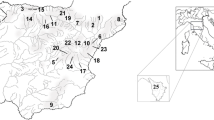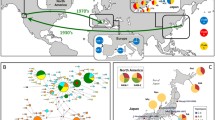Abstract
The order of Acipenseriformes (sturgeon and paddlefishes) contains the economic most valuable species in world trade: the producers of black caviar. Mainly because of their high economic value, sturgeon and paddlefishes were and are the goal of many conservation programs worldwide. In this review, I present some of the main conclusions that can be drawn from previous conservation efforts. My review is divided into two parts. The first part deals with species identification methods, which are necessary for international trade control (Convention on International Trade in Endangered Species of Wild Fauna and Flora). Considering the outcome of all previous forensic studies, I conclude, firstly, it is necessary to use large sample sizes to avoid misinterpretation of possible diagnostic substitutions, and, secondly, the combination of both DNA types (mitochondrial and nuclear markers) is recommended for correct species identification. The second part deals with the influence of restocking/release programs on native populations. The outcome of previous stocking efforts indicates that, in most cases, stocking with nonnative specimens is economically nonsense because most translocation efforts failed. In addition, in cases where such efforts were successful, they influenced negatively the genotypic structure (inbreeding and outbreeding depressions) of native populations. In fact, nonnative stocking does jeopardize adaptation and blurs the genetic differences used to discriminate populations. Furthermore, if it is necessary to release individuals to avoid extinction, released specimens should be as young as possible (homing fidelity).
Similar content being viewed by others
References
Arefjev VA (1997) Sturgeons hybrids: natural reality and practical prospects. Aquac Mag 7/8:52–58
Arlati G, Bronzi P, Colombo L, Giovannini G (1988) Induced breeding of the Italian sturgeon (Acipenser naccarii) raised in captivity (in Italian). Riv Ital Acquac 23:94–96
Birstein VJ, Doukakis P, Sorkin B, DeSalle R (1998) Population aggregation analysis of three caviar-producing species of sturgeons and implications for the species identification of black caviar. Conserv Biol 12:766–775
Birstein VJ, Doukakis P, DeSalle R (2000) Polyphyly of mtDNA lineages in the Russian sturgeon, Acipenser gueldenstaedtii: forensic and evolutionary implications. Conservation Genetics 1:81–88
Birstein VJ, Ruban G, Ludwig A, Doukakis P, DeSalle R (2005) The enigmatic Caspian Sea Russian sturgeon: how many cryptic forms does it contain? Syst Biodivers 3:203–218
Boeckmann S, Rebeiz-Nielsen N (2000) Kaviar. Augustus-Verlag, München
Born B (1999) Review of the state of world fishery resources: inland fisheries. FAO Fish Circ No 942, FAO, Rome
Congiu L, Dupanloup I, Patarnello T et al (2001) Identification of interspecific hybrids by amplified fragment length polymorphism: the case of sturgeon. Mol Ecol 10:2355–2359
de la Herran R, Robles F, Martinez-Espin E, Lorente JA, Rejon CR, Garrido-Ramos MA, Rejon MR (2004) Genetic identification of western Mediterranean sturgeons and its implication for conservation. Conservation Genetics 5:545–551
DeSalle R, Birstein VJ (1996) PCR identification of black caviar. Nature 381:197–198
Dover G (1986) Molecular drive in multigene families: how biological novelties arise, spread and are assimilated. Trends Genet 2:159–165
East ML, Hofer H, Cox JH, Wulle U, Wiik H, Pitra C (2001) Regular exposure to rabies virus and lack of symptomatic disease in Serengeti spotted hyenas. Proc Natl Acad Sci U S A 98:15026–15031
Hett AK, Ludwig A (2005) SRY-related (Sox) genes in the genome of European Atlantic sturgeon (Acipenser sturio). Genome 48:181–186
Hett AK, Pitra C, Jenneckens I, Ludwig A (2005) Characterization of the Sox9 gene in European Atlantic sturgeon (Acipenser sturio). J Heredity 96:150–154
Holcik J (1989) The freshwater fishes of Europe, vol 1 (part II): general introduction to fishes, Acipenseriformes. AULA-Verlag, Wiesbaden
Hufford KM, Mazer SJ (2003) Plant ecotypes: genetic differentiation in the age of ecological restoration. Trends Ecol Evol 18:147–155
Ivanov VP (2000) Biological resources of the Caspian Sea. KaspNIRKH Astrakhan
Jenneckens I, Meyer JN, Debus L, Pitra C, Ludwig A (2000) Evidence of mitochondrial DNA clones of Siberian sturgeon, Acipenser baerii, within Russian sturgeon, Acipenser gueldenstaedtii, caught in the River Volga. Ecol Lett 3:503–508
Jenneckens I, Meyer JN, Hörstgen-Schwark G, May B, Debus L, Ludwig A (2001) A fixed allele at microsatellite LS-39 is characteristic for the black caviar producer Acipenser stellatus. J Appl Ichthyol 17:39–42
Khodorevskaya RP, Dovgopol GF, Zhuravleva OL et al (1997) Present status of commercial stocks of sturgeons in the Caspian Sea basin. Environ Biol Fish 48:209–220
Kirschbaum F, Ludwig A, Hensel E et al (2004) Status of the project on restoration of Atlantic sturgeon in Germany: background, current situation, and perspectives. BFN-Skripten 101:36–53
Krieger J, Fuerst PA (2002) Evidence for a slowed rate of molecular evolution in the order Acipenseriformes. Mol Biol Evol 19:891–897
Ludwig A, Kirschbaum F (1998) Comparison of mitochondrial DNA sequences between the European and the Adriatic sturgeon. J Fish Biol 52:1289–1291
Ludwig A, Debus L, Lieckfeldt D, Wirgin I, Benecke N, Jenneckens I, Williot P, Waldman JR, Pitra C (2002a) When the American sea sturgeon swam east. Nature 419:447–448
Ludwig A, Debus L, Jenneckens I (2002b) A molecular approach for trading control of black caviar. Int Rev Hydrobiol 87:661–674
Ludwig A, Congiu L, Pitra C, Fickel J, Gessner J, Fontana F, Patarnello T, Zane L (2003) Nonconcordant evolutionary history of maternal and paternal lineages in Adriatic sturgeon. Mol Ecol 12:3253–3264
Martin C, Alonso JC, Morales MB, Pitra C (2000) An approach to sexing young great bustards Otis tarda using discriminant analysis and molecular techniques. Bird Study 47:147–153
Martin CA, Alonso JC, Alonso J, Pitra C, Lieckfeldt D (2002) Great bustard population structure in central Spain: concordant results from genetic analysis and dispersal study. Proc R Soc Lond Biol Sci 269:119–125
Pitra C, Kock RA, Hofmann RR, Lieckfeldt D (1998) Molecular phylogeny of the critically endangered Hunter's antelope. J Zoolog Syst Evol Res 36:179–184
Pitra C, Lieckfeldt D, Alonso JC (2000) Population subdivision in Europe's great bustard inferred from mitochondrial and nuclear DNA sequence variation. Mol Ecol 9:1165–1170
Pitra C, Hansen AJ, Lieckfeldt D, Arctander P (2002) An exceptional case of historical outbreeding in African sable antelope populations. Mol Ecol 11:1197–1208
Pitra C, D'Aloia MA, Lieckfeldt D, Combreau O (2004) Genetic variation across the current range of the Asian houbara bustard. Conservation Genetics 5:205–215
Raymakers C (2002) International trade in sturgeon and paddlefish species—the effect of CITES listing. Int Rev Hydrobiol 87:525–537
Rehbein H (1997) Fischartbestimmung von Caviar durch Protein-und DNA-Analyse. Informationen der Fischwirtschaft 44:27–30
Robles F, de la Herran R, Ludwig A, Ruiz-Rejon C, Ruiz-Rejon M, Garrido Ramos M (2004) Evolution of ancient satellite DNAs in sturgeon genomes. Gene 338:133–142
Robles F, de la Herran R, Ludwig A, Ruiz-Rejon C, Ruiz-Rejon M, Garrido Ramos M (2005) Genomic organization and evolution of the 5S ribosomal DNA in the ancient fish sturgeon. Genome 48:18–28
Schram ST, Lindgren J, Evrard LM (1999) Reintroduction of lake sturgeon in the St. Louis River, western Lake Superior. North Am J Fish Manage 19:815–823
Tranah G, Campton DE, May B (2004) Genetic evidence for hybridization of pallid and shovelnose sturgeon. J Heredity 95:474–480
Ugarkovic D, Plohl M (2002) Variation in satellite DNA profiles—causes and effects. EMBO J 21:5955–5959
Wolf C, Hübner P, Lüthy J (1999) Differentiation of sturgeon species by PCR-RFLP. Food Res Int 32:699–705
Zane L, Patarnello T, Ludwig A, Fontana F, Congiu L (2002) Isolation and characterization of microsatellites in the Adriatic sturgeon (Acipenser naccarii). Mol Ecol Notes 2:586–588
Acknowledgements
This paper is dedicated to Professor Christian Pitra on the occasion of his 65th birthday, 29 April 2006. I met Christian Pitra for the first time during my diploma. He was not really interested in my research at this time. However, 7 years and a few joined publications in international high-ranked journals later, he invited me to move in his research group at the Institute for Zoo and Wildlife Research. I always enjoyed his constructive pessimism during the whole time. What separates him from most other scientists is that he is not only intelligent, but has also a great strategic ability. Taken together, I am very thankful for his fruitful contributions to my research and his support for my habilitation. I wish him all the best for the future.
Author information
Authors and Affiliations
Corresponding author
Rights and permissions
About this article
Cite this article
Ludwig, A. A sturgeon view on conservation genetics. Eur J Wildl Res 52, 3–8 (2006). https://doi.org/10.1007/s10344-005-0006-2
Received:
Accepted:
Published:
Issue Date:
DOI: https://doi.org/10.1007/s10344-005-0006-2




